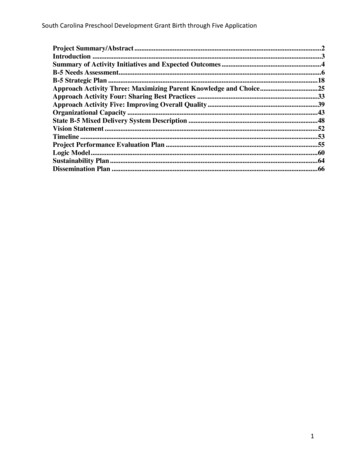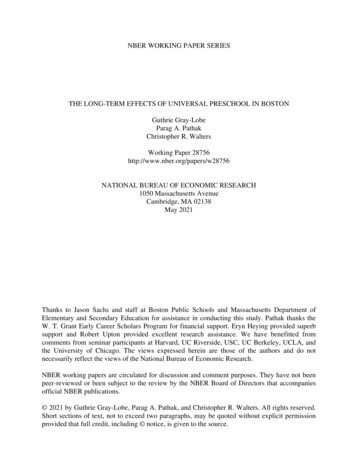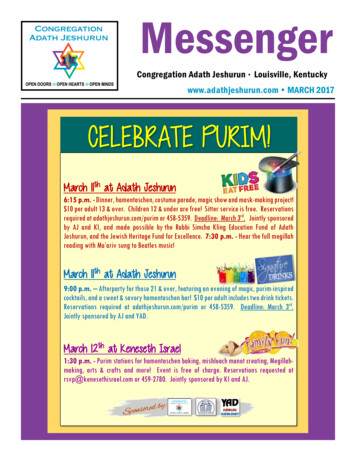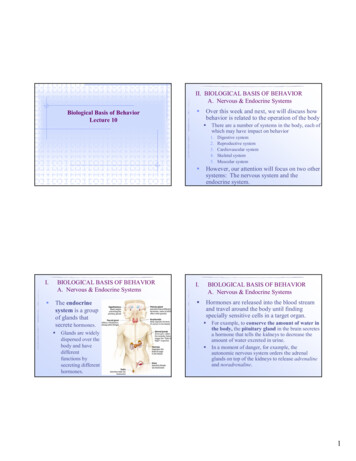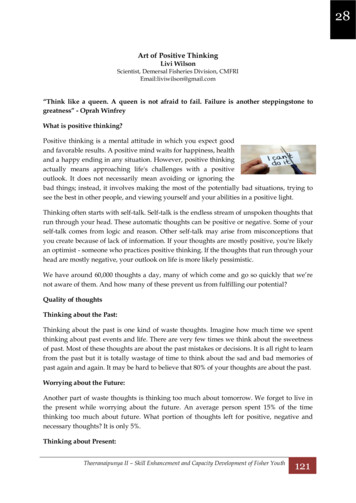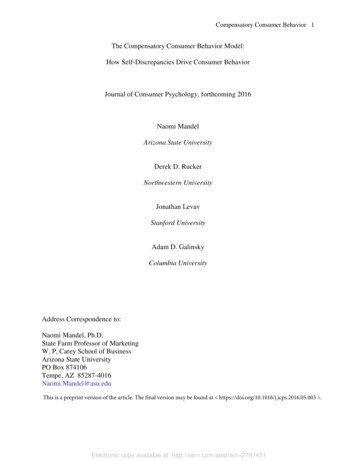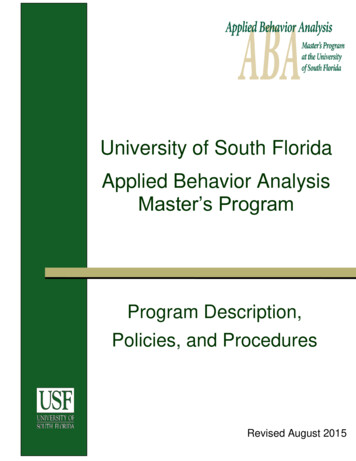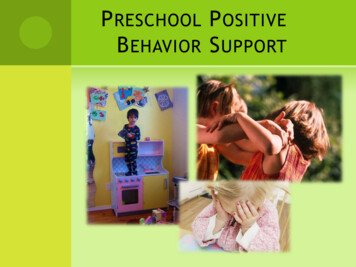
Transcription
P RESCHOOL P OSITIVEB EHAVIOR S UPPORT
If there is anything that wewish to change in the child, weshould first examine it and seewhether it is not something thatcould better be changed inourselvesCarl Jung
RTI/SWBSSchool-wide Systems forSuccess (includes Behaviorand Academic Instruction)School-wide PositiveBehavior Support modelhttp://www.oregonsd.org/schools/omspbis.cfm
D EFINE P OSITIVE B EHAVIORS UPPORT (PBS)PBS is a way to reduce challengingbehaviors by increasing desirablebehaviors through prevention,positive consequences, andteaching appropriate behaviors(Conroy, et al. 2005).
ingskills.pdf
Piagetian Terms:Type of reasoningReasoning Characterized resentation(has a mentalimage of whatshould occurwhen acting onobjects andperformsactions toconfirm Tertiary CircularReactions(Tries out actingon objects,knows his/heractions cause aneffect) SensorimotorStage 6Approx. nsorimotorStage 5Approx. 12-18months“Put-er In-er” ImplicationsBegins to pictureobjects and eventsmentallyForesight instead oftrail and errorImitates models notcurrently present inthe environment Trial and errorproblem-solvingImitation of a widerange of models ifcurrently present inthe environmentKeen observer ofactions and theirresults; copiesothers’ actions Imitates observed routinesUses materials to represent previousexperiences and current mentalimages, e.g., household routinesWords as symbols is evolvingGeneralized rules not understood –Understands communication prosody(voice tones & facial affect) andenvironmental cues more thanlanguageUnderstands some objects havefunctionsContinually manipulating materials,mastering body movements andactions on objectsNo rules understood. Understandscommunication prosody (voice tone &facial affect) and environmental cuesmore than ofreasoningskills.pdf
Piagetian Terms:IntuitivePreoperationalStage IIApprox. 4-7 e 1Approx. 2-4 years“Associater”Type of reasoningReasoning Characterized byPre-logicalJustifies fromownperspective(Attempts tolink things intocause/effectbased on ownwhimsy. Asks“why” todetermineassociations &cause/effect) Pre-logicalAssociatesFreely(Knows someactions occur inassociation butdoes not knowwhat causesoccurrences) ImplicationsPersonal experiencebegins to bemediated byconceptsConsiders only onevariable at a time inproblem solvingAttempts to explaincause and effect butstill perceptionboundStill unable to acceptidea that othersthink differently Reasoning is basedonly on memory ofprevious experiencesor immediateperceptionsChild is unable totake the view pointof othersExperiences triggermemories of earlierexperiences ingskills.pdf Beliefs can be easily shaken or rigidly heldNo adult logic as of yetEfforts to make sense of the world, establishcause/effect, but in initial stage andidiosyncraticInconsistencies due to perception boundreasoningWants rules to adhere to personal in-themoment needs, tries to persuade othershis/her viewpoint is the correct one.Attempts to negotiate but limitedperspective taking“Seeing is believing”Responses tend to be immediate with nocognitive mediationInconsistencies result from idiosyncrasies inexperiencesNo consistent cause and effect relationships,child just knows some things (objects/ideas)co-occurAccepts rules as absolutes, with protest oracceptance when adult gives the rul.Negotiation skill absent or barely emerging
Pyramid Model for Promotingthe Social and EmotionalDevelopment of Young ChildrenTHINKENGAGEMENT
Tier One Supports Establish a clear set of expectations Teach children those expectations Consistently reinforce children who followthose expectations Decrease the number of transitions whenpossible Use transitions as a teaching time forappropriate behavior
Focus on more directlyteaching social skills A sense of confidence and competence Ability to develop good relationshipswith peers and adults/make friends/getalong with others Ability to persist at tasks Ability to follow directions Ability to identify, understand, andcommunicate own feelings/emotions Ability to constructively manage strongemotions Development of empathy
Tier Two Supports Visual cues for behavior Teach, re-teach and practicesocial skills Social Stories
Turtle TechniqueRecognizethat you“Think”Stop.feel angry.Go into shell.Take 3 deepbreathes.And thinkcalm, copingthoughts.Come outof shellwhen calmand think ofa solution.
Tier Three Supports Functional BehaviorAssessment (FBA) Behavior Intervention Plans(BIP) Individualized teachingprograms
This presentation willfocus on the first level ortier of the pyramid. It isour belief that with wellplanned and consistentuse of Level 1 strategies,you may prevent the needfor higher levelinterventionsDon’t shoot yourself inthe foot!!!!
How a TEACHERviews the childinfluences how theTEACHERinteracts with thechild whichinfluences who thechild becomes.
“Relationships withchildren, families andother professionalsare key to high-qualityearly childhoodprograms in generaland critical toeffectively dealingwith children withchallenging behavior.”
Research shows that themain predictor ofachievement is a child’sperception of“Does the teacher like me?”From: Linda Brault
You are your most POWERFUL toolAdult child relationships may be the most powerful toolfor working with young childrenGreet children by nameGive children real choicesGet down to the child’s level when talking tothemBe consistent with childrenPlay with childrenTell children it is ok to feel sad, angry, or hurtTry to spend time one to one with each childUse personal information about the child inBlended Practices page 250conversations
Building and Supporting Relationships
D ESIGNING S UPPORTIVE E NVIRONMENTS“The goal of effectiveclassroom management isnot creating “perfect”children, but providing theperfect environment usingresearch-based strategiesthat guide students towardincreasingly responsible andmotivated behavior.”(Sprick, Knight, Reinke & McKale, 2006, p. 185)
“Studies indicate that approximately fourof every five disruptive students can betraced to some dysfunction in the wayschools are organized, staff memberstrained, or schools are run.”(U.S. Department of Education, 2000)
P HYSICAL E NVIRONMENT: G UIDELINES Arrange traffic patterns to reduce open spaces Remove obstacles that make it difficult forchildren to move around the room Include learning materials that will likelypromote children’s interactions Use pictures and labels to tell children wherethings belong Limit the number of children in a given learningcenter Use picture posters and schedules to helpchildren know what to doBlended Practices page 254
C ARA’ S K IT
S CHEDULES , R OUTINES ,ANDT RANSITIONS Design a schedule that works for your specific group of children Balance activities-quiet and noisy, active and passive, largegroup and small group, adult directed and child directed Implement the schedule consistently Teach children the schedule and expectations related to theschedule Alert children about transitions Tell children when there are changes in the schedule Prompt children to help each other during routines andtransitions Structure transitions so that children do not spend significanttime waiting with nothing to doBlended Practices: page 256
THINKENGAGEMENTA CTIVITIES DESIGNED TO PROMOTEE NGAGEMENT Monitor children’s attention and adjust activitiesaccordingly Have a purpose or goal for each activity Provide opportunities for active childparticipation Design activities with individual children’s goalsand interests in mind Vary topics and activities from day to day Give children jobs during group activities Assign adults to support children who havedifficulty attending during group activitiesBlended Practices: page 258
THINKENGAGEMENTT EACHER ( ADULT ) B EHAVIORS THATPROMOTE E NGAGEMENT Attend to children when they are engaging inappropriate behaviors. Provide descriptive feedback to children Give children directions that are explicit Give children choices Acknowledge children’s efforts
Universal PositiveBehavior Support(PBS) PracticesFrom: Benedict, E., Horner, R., & Squires, J. (2007). Assessment and Implementation of Positive BehaviorSupport in Preschools. Topics in Early Childhood Special Education 27:3, 174-192.
1. R ULES POSTER WITH THREE TOFIVE POSITIVELY STATED RULESPosters may be of any size, as long as theyare affixed to a wall no higher than 4 feettall and not blocked partially or in full byfurniture or other materials.Must include at least 3 and no more than 5positively stated rules in both picture andwritten forms.
39
THINKENGAGEMENTC LASSROOM R ULES ANDE XPECTATIONS Identify a small number of class rules Involve the children in developing the rules State the rules positively (“use inside voices;”“be nice to our friends”) Explicitly teach the rules and reinforce themin context Provide opportunities for practicing the rules Have consistent consequences when childrenbreak the rules Teach children about consequencesBlended Practices: page 258
2. P OSTED CLASSROOM SCHEDULEClassroom schedule includes sequencedpictures of classroom routines and isposted at eye level for children.Schedule includes words and/or picturesand is affixed to a wall no higher than 4feet tall and not blocked partially or in fullby furniture or other materials
3. CLASSROOM MATRIX OF BEHAVIORALEXPECTATIONS FOR EACHCLASSROOM ROUTINEClassroom matrix includes behavioralexpectations for each classroom routine (e.g.,free play, circle time, snack).Matrix can be of any size and located on eithera wall or in a teacher’s materials (e.g., binder,folder), as long as it is easily accessed by thelead teacher or other support staff. Eachclassroom routine must be depicted on thematrix, as well as each classroom rule.Some expectations (less than 80%) may repeatacross routines (e.g., keep hands to self in circleand free choice).
4. T RANSITION SIGNALTeachers use a system other than or inaddition to a verbal direction to signal atransition from one activity to another.Signal may be auditory (e.g., ringing a bell,singing a song), physical (e.g., puttinghand on head), visual (e.g., turning offlight momentarily), or gestural (e.g.,pointing to a picture).Signal must accompany or be no laterthan 10 seconds after a verbal direction.
5. WARNING PRIOR TOTRANSITIONSTeachers provide a warning before atransition from choice, free play, oroutside play to another activity.Teachers provide a specific warningindicating that the activity will end soon(e.g., “5 more minutes,” “It’s cleanuptime soon”) prior to any child’stransition to the next activity.
6. P RECORRECTIONAt least one teacher makes at least onestatement about expected behavior to oneor more children in the absence ofmisbehavior.“Remember to use your walking feet”before the children walk in the hall, whererunning is common but has yet to occur.
Remember, useyour walking feet.
7. A CKNOWLEDGMENT SYSTEMAt least one teacher makes at least oneacknowledgment of a child’s appropriate behavior,using a systematic procedure other than praise.May include activities such as giving children lotionfor coming inside from the playground right awayor letting children wear the “Super Friend” capeafter they help a friend.Acknowledgment in the form of praise is included ifthe praise is systematic and consistent acrossteachers for the particular activity, such asrecognizing children who are sitting appropriatelyat each circle.
Relating Development to Common Behavior evelopment.pdf
SuperFriend Intermittently give Skittles, JellyBeans or M&Ms as children cometo sit quickly at circle orremember to use their walkingfeet and quiet voices in the hall. “Super Friend” cape or button forbeing a good friend and helping afriend or the teacher.
8. R ATIO OF 4 POSITIVE STATEMENTSTO 1 NEGATIVE STATEMENTTeachers use ratio of 4 positive statements to 1 negativestatement. Include all teacher statements in tally. Positivestatements are defined as teacher statements made to one ormore children that include praise or indicate approval.“I like how Billy is sitting criss-cross applesauce,” and“Thank you for putting your picture in your cubby,”Nonspecific positive statements, such as “Thank you,” “That wasnice,” or “Good job,” are also included.Negative statements are defined as teacher statements to childrenthat include a reprimand, correction, or indicate disapproval.“Stop that,” “Use a quiet voice inside,” and “You’ve made Nicosad. Please say you’re sorry.”
9. S PECIFIC S OCIAL P RAISEAt least one teacher makes at least onepositive and specific verbal comment toa child immediately following his or herappropriate behavior.“You were a nice friend to share withEva,” “Good job finding your name,” and“I liked how you used your words to tellme you were upset.”Nonspecific verbal praise—such as “Nicejob” or “Great!”—are not included.
R ESOURCES http://csefel.vanderbilt.edu/ http://www.challengingbehavior.org/ http://www.pyramidplus.org/ http://prekese.dadeschools.net/ http://www.pent.ca.gov.index.htm
Elizabeth A. BenedictPurdue UniversityRobert H. HornerJane K. SquiresUniversity of OregonTECSE 27:3 174-192 (2007)
QUESTIONS
8. RATIO OF 4 POSITIVE STATEMENTS TO 1 NEGATIVE STATEMENT Teachers use ratio of 4 positive statements to 1 negative statement. Include all teacher statements in tally. Positive statements are defined as teacher statements made to one or more children that include praise or indicate approval

